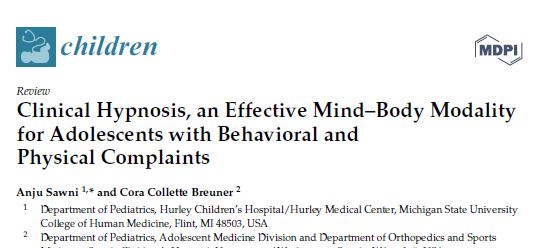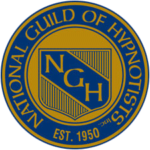This article contains a parts from a review paper shared here as an educational tool. You can find the full study PDF document by scrolling down. Contact Ethan Wise with any questions pertaining to the use of hypnotherapy with children, and adults.
 Abstract:
Abstract:
Abstract:
Mind-body medicine is a system of health practices that includes meditation/relaxation training, guided imagery, hypnosis, biofeedback, yoga, art/music therapy, prayer, t’ai chi, and psychological therapies such as cognitive behavioral therapy.
Clinical hypnosis is an important mind–body tool that serves as an adjunct to conventional medical care for the adolescent patient. Clinical hypnosis specifically uses self-directed therapeutic suggestions to cultivate the imagination and facilitate the mind–body connection, leading to positive emotional and physical well-being. There are many similarities between clinical hypnosis and other mind–body/self-regulatory modalities such as visual imagery, mindfulness meditation, yoga, and biofeedback that incorporate experiential learning and mechanisms for change. They may be viewed as subtypes of the hypnotic experience and share the common experience of trance as the entrée into self-empowered change in physiologic and psychological states.
Clinical hypnosis can be used by health care providers to teach adolescents coping skills to deal with a wide variety of conditions such as chronic headaches, recurrent abdominal pain, anxiety, depression, grief and bereavement, phobias, anger, family stressors, sleep disorders, or enuresis [involuntary urination].
Keywords: mind–body therapies; adolescents; pain; headache; stress; anxiety; depression; hypnosis; guided imagery; mindfulness; emotional regulation
Introduction:
Mind–body medicine is a philosophy and a system of health practices that enlist the mind in improving emotional well-being and physical health. These practices include meditation/relaxation training, guided imagery, hypnosis, biofeedback, yoga, art/music therapy, prayer, t’ai chi, and psychological therapies such as cognitive behavioral therapy [CBT].
Mind–body therapies focus on balancing the autonomic nervous system (ANS) by activating the parasympathetic branch of the ANS to reduce the sympathetic physiological response to stress and by regulating the hypothalamic pituitary adrenal axis [H-P-A axis], both of which are indicators of stress.
This reduction of stress on the mind and body may help control or reverse certain underlying disease processes.
Evidence suggests that the mind and body have constant bidirectional communication through neuro-endocrine, neuro-chemical, immunological, and energetic pathways. Higher cognitive centers and limbic emotional centers are capable of regulating virtually all aspects of the immune system and therefore have a profound effect on health and illness-termed psychoneuroimmunology [1–3]
..
These therapies may improve the quality of life and reduce the physical symptoms for adolescents with various chronic diseases. Data from the 2012 National Health Interview Survey show that mind–body therapies were used in adolescents aged 13 to 17 years, and more often among females versus males (5.7% vs. 1.7%).
Children and youth were more likely to use mind–body therapies for pain-related conditions or emotional, behavioral, or mental conditions and if they received specialty or mental health care. The most common reasons for the use of mind–body therapies were to improve overall health/general wellness, to reduce stress levels or relax, and to feel better emotionally [4,5]. Mind–body therapies such as clinical hypnosis are considered safe and can be effective for adolescents with medical conditions such as tension or migraine headaches, enuresis, recurrent abdominal pain, constipation, sleep difficulties, acute or chronic pain, anxiety, and other emotional and stress-related symptoms [6,7]. 2. Stress and the Developing Adolescent Brain Adolescence is a period of rapid physical growth, intellectual and cognitive development, as well as a time for creating autonomy, and promoting both self-esteem and strong peer relationships.
During adolescence, teens experience the ebb and flow of emotions between self-confidence, insecurity, invincibility, anxiety, worry, doubt, and self-worth as a result of rapid changes occurring in the brain and neuro-biological and neuro-endocrine systems.
The rapidly developing adolescent brain is sensitive to stress and adverse events due to changes in hormones and the plasticity in the structure and function of the brain [8]. Brain development during adolescence involves changes in the frontal and parietal cortices, the site of higher-order cognitive and socioemotional processes (i.e., executive function). The cortex is fine-tuned through synaptic pruning in areas that play a role in judgment, impulse control, planning, and emotion regulation [9–11]. Glucocorticoid receptors are found in the amygdala, hippocampus, and prefrontal cortex (PFC); exposure to stressful experiences (leading to increase in glucocorticoids) has been shown to alter the size and neuronal architecture of these areas as well as lead to functional differences in learning, memory, and other aspects of executive functioning. Specifically, chronic stress is associated with hypertrophy and over-activity in the amygdala and orbitofrontal cortex, and can lead to loss of neurons and neural connections in the hippocampus and medial PFC.
The PFC turns off the cortisol response and regulates the autonomic balance (i.e., sympathetic versus parasympathetic effects), it also plays an important role in the development of executive functions, such as decision-making, working memory, behavioral self-regulation, and mood and impulse control [12]. The consequences of structural changes in the brain include more anxiety related to both hyper activation of the amygdala and less control as a result of PFC atrophy, as well as impaired memory and mood control due to hippocampal reduction [13]. The adolescent brain is particularly vulnerable to stressors in the youth’s social and emotional environment. Executive functions, such as the ability to direct attention and solve problems efficiently, the awareness of threat, and effective fear processing are diminished when there are significant emotional stimuli during adolescence [14–17].
Rapid neurobiological changes during times of emotional stress may predispose adolescents to difficulties with emotion regulation [8]. Difficulties in emotion regulation are a feature of many emotional and behavioral problems seen in adolescents, including anxiety, depression, conduct problems, cutting, disordered eating, and substance abuse [18–20].
The prevalence of mental health disorders is 22% in adolescents 13 to 18 years old. Anxiety disorders are the most common condition (31.9%), followed by behavior disorders (19.1%), mood disorders (14.3%), and substance use disorders (11.4%). Approximately 40% of those with one class of disorder also meet criteria for another class of lifetime disorder [21,22]. Children 2017, 4, 19 3 of 12 With increasing exposure to technology and screen time (on smart phones, computers, television, and social media sites), more mental health concerns, and persistent economic, racial, and ethnic disparities in health status, we now have new morbidities in adolescents called the ‘millennial morbidities’. These morbidities may lead to stress-related problems such as chronic headaches, abdominal pain, anxiety, depression, and other emotional problems [23].
Adolescents who experience emotional stress often complain of chronic physical symptoms that respond poorly to standard medications. Cognitive and emotion regulation, including the ability to modulate responses to stress, is increasingly found to contribute to overall adjustment, including social emotional development (e.g., peer relations).
Mind–body/self-regulation therapies such as clinical hypnosis operate at the physiological, attentional, emotional, cognitive, and behavioral levels and teach adolescents’ coping skills to control their inner wellbeing with respects to thoughts, emotions, attention, and performance [24,25].
Research shows that mind–body/self-regulation therapies can help develop appropriate connections between the relevant prefrontal structures in adolescents, thereby stabilizing arousal and reducing harmful risk-taking behaviors [26]. They may reduce the impact of stress-related conditions, lessen depression and anxiety, alleviate pain, improve quality of life, and increase emotion regulation and subjective well-being [27–34].
Conclusions:
Clinical hypnosis is a natural state that can be cultivated, with permission from the adolescent and builds on the adolescent’s existing strengths and interests. It is an altered state of consciousness (awareness and alertness) within a focused state (with or without physical relaxation), in which an individual is selectively focused, absorbed, and concentrating upon a particular idea or image aimed at improving mental or physical health.
Clinical hypnosis is a teachable skill that most adolescent patients are able to learn with minor effort, and is safe, effective, and free of adverse side effects in trained hands. Hypnosis promotes the cultivation of imagination and patients’ positive expectations and motivation for success.
Hypnosis in adolescents is more permissive and less directive than in adults, as it utilizes the natural hypnotic abilities that teens bring to the clinical encounter. As a result, adolescents can enter into the hypnotic state quicker and easier than adults and are highly responsive to therapeutic suggestions/goals (hypnotherapy).
Examples of therapeutic suggestions include decreasing or eliminating undesirable symptoms, reframing and rethinking distorted thoughts about situations and stressors, building positive expectations, and re-enforcing control over reaction to problems/situations, and strengthening the concept/belief in the ability of the mind and body to work together to create desirable changes in behavior/outcome. Clinical hypnosis allows the adolescent to gain a sense of control, increase self-esteem and competence, and reduce stress, therefore helping them to manage their physical and emotional well-being.
For some problems, hypnosis may be the treatment of choice (e.g., enuresis, headaches, abdominal pain, procedural pain/anxiety, and adjustment reaction to stress). For more complex problems/conditions, hypnosis may be more adjunctive but a highly effective and important modality in the overall management
Read the full study here ClinicalHypnosisEffectiveModalityBehaviorPain.pdf







